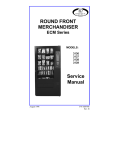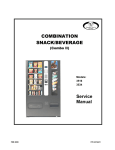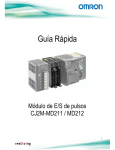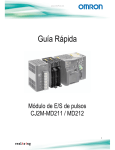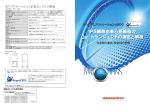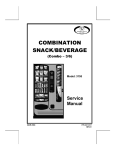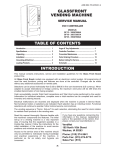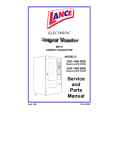Download CAC / BDP BW4BAH-126 Instruction manual
Transcript
Electric Heaters 5---20 kW SMALL PACKAGED PRODUCTS (SPP) Accessory Electric Heaters For 13 SEER, R---410A, Z Chassis Installation Instructions NOTE: Read the entire instruction manual before starting the installation. SAFETY CONSIDERATIONS Improper installation adjustment, alteration, service, maintenance, or use can cause explosion, fire, electrical shock, or other conditions which may cause death, personal injury, or property damage. Consult a qualified installer, service agency, or your distributor or branch for information or assistance. The qualified installer or agency must use factory--authorized kits or accessories when modifying this product Refer to the individual instructions packaged with the kits or accessories when installing. Follow all safety codes. Wear safety glasses, protective clothing, and work gloves. Use quenching cloth for brazing operations. Have a fire extinguisher available. Read these instructions thoroughly and follow all warnings or cautions included in literature and attached to the unit. Consult local building codes, the current editions of the National Electrical Code (NEC) NFPA 70. In Canada refer to the current editions of the Canadian Electrical Code CSA C22.1. . Recognize safety information. This is the safety--alert symbol When you see this symbol on the unit and in instructions or manuals, be alert to the potential for personal injury. Understand these signal words; DANGER, WARNING, and CAUTION. These words are used with the safety--alert symbol. DANGER identifies the most serious hazards which will result in severe personal injury or death. WARNING signifies hazards which could result in personal injury or death. CAUTION is used to identify unsafe practices which may result in minor personal injury or product and property damage. NOTE is used to highlight suggestions which will result in enhanced installation, reliability, or operation. Before proceeding with heater installation, inspect thoroughly for shipping damage. Notify shipper immediately if any damage is found. Clean all dirt, dust and moisture from heater package. Check for proper clearances of live parts, between phases and to ground. Make sure that all required barriers are in place. Check conductors run in multiple to insure that they are properly wired. Refer to unit installation instructions for complete unit installation details. The minimum air quantity for safe electric heater operation is shown in Table 2. ! DESCRIPTION AND USAGE These heaters are comprised of a separate heater module mounted on the blower inlet and remote mounted controls located in the unit control box. Heater models are provided with single point electrical connections for powering both the heater and the unit. These heaters are intended for use only in SPP units as noted in Table 1. PACKAGE CONTENTS Electric Heater Package Contents 1. Heater assembly, comprised of heater module and control panel 2. UPC heater label 3. Installation Instructions 4. Identification label 5. Wiring label 6. Wire connectors (2) 7. Wire tires--6” (5) 8. Screws #10B (4) 9. Ground lug (1) (See Fig. 7) 10. Bolts 3/8--16 (3) 11. Plug attachment plate INSTALLATION Heater Installation 1. Open all electrical disconnects and install lock--out tag before beginning any installation or service work. 2. Check for proper heater application in Table 1. 3. Remove unit side panel to access blower compartment (See Fig. 1). 4. Disconnect wiring to motor by removing speed selection and power plugs from bottom of motor. 5. Remove rear blower support bracket. Remove shipping block and label under blower if unit has one. 6. Remove screws securing blower to front blower support bracket; slide blower out of unit. 7. Open heater package and remove heater module; secure heater module to standoffs on blower inlet with (3) bolts provided (see Fig. 2). Adjust mounting position so that all hardware and sheetmetal clears the heating element wire by at least 1/4 in. Reinstall heater/blower assembly. 8. Reinstall rear motor support bracket and attached motor wiring. Reinsert motor power plug and speed tap plug into motor. The connectors are polarized to prevent mis--wiring. 9. Remove heater wiring cover plate from interior partition between blower and control box (See Fig. 3) and install heater wiring plug attachment plate provided with heater. WARNING ELECTRICAL SHOCK HAZARD Failure to follow this warning could result in personal injury or death. Before performing installation, service or maintenance operations on this system, turn off all main power to system. There may be more than one disconnect switch. Turn off accessory heater power switch if applicable. Lock out and tag switch with a suitable warning label. 1 Table 1 – Electric Heater Usage Chart Air Conditioner Models (PAC) Heat Pump Models (PHP) CPHEATER Agency Approval kW V PH Circuit Breaker 24 30 36 42 48 60 24 30 36 42 125 UL 5 208/240 1 N √ √ √ √ √ √ √ √ √ √ 126 UL 5 208/240 1 Y √ √ √ √ √ √ √ √ √ 127 UL 7.5 208/240 1 N √ √ √ √ √ √ √ 128 UL 7.5 208/240 1 Y √ √ √ √ √ √ √ √ 129 UL 10 208/240 1 N √ √ √ √ √ 130 UL 10 208/240 1 Y √ √ √ √ √ √ √ √ 131 UL 15 208/240 1 Y √ √ √ √ 132 UL 20 208/240 1 Y √ √ Air Conditioner Unit Size 24 30 36 42 48 60 X= Not Approved Combination Heat Pump Unit Size 24 30 36 42 48 60 X= Not Approved Combination 48 60 √ √ √ √ √ √ √ √ √ √ √ √ √ √ √ √ √ Table 2 – Minimum Airflow for Heater Operation Minimum Airflow (CFM) 5 kW 7.5 kW 10 kW 600 750 750 600 750 750 600 750 750 600 750 750 600 750 750 600 750 750 15 kW X X 1050 1050 1050 1050 20 kW X X X X 1400 1400 Minimum Airflow (CFM) 10 kW 800 800 800 800 800 800 15 kW X X 1200 1200 1200 1200 20 kW X X X X 1700 1700 5 kW 750 750 750 750 750 750 7.5 kW 800 800 800 800 800 800 10. Remove unit front panel to access unit control box compartment. 11. Open heater package and remove heater control panel; set heater control panel on top of unit (See Fig. 4). 12. Heater control panel will have black and yellow power wires ending in panel mounted plugs; reach through large rectangular opening in control panel and snap these plugs into mating openings in heater wiring plug attachment plate installed in step 9 above (See Fig. 3). 13. Rotate heater control panel into unit control box area and locate it into top left corner of control box; secure heater control panel to unit control box with (4) screws provided (See Fig. 5). 14. Open flexible “fishpaper” insulation cover provided with unit control box and route heater low voltage wires along the bottom of the unit control box. Route low voltage leads from heater relay(s) through hole in unit control box and into low voltage splice box. (See Fig. 5 and 6.) dress wires and secure them to existing unit control wires with wire ties provided (See Fig. 6). 15. Re--close flexible “fishpaper” insulation cover; insure unit black and yellow power “pigtails” from contactor are properly routed through insulation cover (See Fig. 7). 16. Connect the black and yellow “pigtails” from the heater control panel to the black and yellow pigtails from the unit contactor using the connectors provided with the heater. 17. Attach the adhesive backed wiring label provided with the heater to the back of the access panel near the unit wiring label. 18. Return to blower compartment and locate black and yellow power wires from heater module; these wires will terminate in plug connectors that mate with the plug from the heater control installed in Step 13 above. Snap these connectors into place; dress and secure wires to fan wires with wire ties provided (See Fig. 8). 19. The factory speed tap for electric heat operation is tap 2. Refer to blower performance table in the unit installation instructions or pre--sale literature to determine available airflow at duct system external static pressure. Compare the actual airflow with the minimum required airflow from Table 2. If tap 2 airflow is lower than minimum required airflow, recheck blower performance table to see if minimum airflow can be achieved on tap 3. If tap 3 airflow meets the minimum CFM requirement, change speed tap for electric heat from tap 2 to tap 3 in unit control box. See unit instructions and wiring diagram. If tap 3 airflow does not achieve minimum CFM requirement, then another electric heater that meets the minimum CFM requirement must be used. 20. Reattach the blower access panel and proceed to ELECTRICAL CONNECTION. 2 BLOWER MOTOR BLOWER SUPPORT BRACKET SPEED SELECTOR & POWER PLUG A05382 Fig. 1 -- Indoor Blower Compartment HEATER MODULE BOLTS (3) A10111 Fig. 2 -- Attach Heater Module 3 HEATER WIRING PLUG ATTACHMENT PLATE WITH PLUG INSTALLED COVER PLATE A05384 Fig. 3 -- Inside Blower Compartment Electric Heat Control Box (shown uninstalled) Electric Heat wiring interconnection (electric heater controls removed for clarity) A10031 Fig. 4 -- Unit Control Box Compartment 4 HEATER CONTROL PANEL MOUNTING SCREWS (4) A10119 Fig. 5 -- Heater Control Panel Installation HEATER RELAY LOW VOLTAGE WIRES FISH PAPER (Shown in down position for installation and service) A10120 Fig. 6 -- Heater Low Voltage Connection 5 SINGLE POINT CONNECTION GROUND LUG POWER SUPPLY FOR CONTACTOR FIELD HIGH VOLTAGE SUPPLY FISH PAPER LOW VOLTAGE WIRING COMPARTMENT A10121 Fig. 7 -- Unit Power Connection HEATER PLUG WIRE TIES A05385 Fig. 8 -- Power Connection to Heater 6 START--UP Electrical Connection 1. Open all electrical disconnects and install lock--out tag before beginning any installation or service work. 2. All electrical connections, wire sizes and type of conduit shall meet the National Electric Code and State and Local Codes. Main power supply, minimum wire sizes, circuits, fusing, etc. are shown on schematic wiring diagrams. NOTE: Use minimum 75°C copper wire only. 3. Refer to base unit instructions for recommended wiring procedures. 4. Connect low voltage wires as shown in unit schematic diagrams. These connections must be made in the 24--v. splice box (See Fig. 7). 5. Connect field power wiring as shown in unit wiring diagram. All connections should be made inside the unit and comply with the National Electric Code and State and Local Codes. Heaters with factory installed circuit breakers may be installed on a branch circuit protected by either a fuse or circuit breaker. For all other heaters, the branch circuit must be protected by a fuse or circuit breaker supplied by others. 6. Make all high voltage wire splice connections inside the unit control box. Use splice connectors provided. Properly insulate connectors. Separate all wires from incoming power leads (See Fig. 7). 7. Be sure that all electrical terminal connections, clamps, screws, etc. are tight before proceeding. 8. Check wiring diagram supplied with heater for specific connections and information (See Fig. 9 thru 16). 9. Check operation as described in Start--Up section. ! ! CAUTION ELECTRICAL SHOCK HAZARD Failure to follow this caution may result in personal injury or death. Before proceeding, verify that all wiring is correct per factory approved schematic. Notify equipment supplier immediately of any discrepancies. 1. Refer to base unit installation instructions as required. 2. Check for loose terminal connections. 3. Check that all fuse and circuit breaker short circuit interrupting ratings are adequate. 4. Turn on unit and heater power. 5. Set thermostat to call for heat. 6. Check operation of heater. 7. Check that airflow across the heater is at or above the minimum recommended CFM requirement (See Table 2). 8. Use of accessory electric heaters that are not tested and approved by the original equipment manufacturer of the packaged air conditioner or heat pump is not recommended and will not be warranted by the original equipment manufacturer. Additionally, damage caused by such heaters to the equipment will not be covered under warranty by the original equipment manufacturer. TROUBLESHOOTING WARNING 1. Circuit Breakers--Malfunction will interrupt power to the unit. Check for cause of failure, reset or replace. 2. Limit Switch--Malfunction prevents heating element(s) from being energized. Replace switch if malfunction occurs. 3. Relay--Malfunction will not allow heater to energize. Replace faulty relay. Do not attempt to repair. ELECTRICAL SHOCK HAZARD Failure to follow this warning could result in personal injury or death. Before performing installation, service or maintenance operations on this system, turn off all main power to system. There may be more than one disconnect switch. Turn off accessory heater power switch if applicable. Lock out and tag switch with a suitable warning label. 7 Stick on label included with kit. See Installation Section, Step 17 (Page 2). A10110 Fig. 9 -- CPHEATER125A00 Wiring Diagram Stick on label included with kit. See Installation Section, Step 17 (Page 2). A10112 Fig. 10 -- CPHEATER126A00 Wiring Diagram 8 Stick on label included with kit. See Installation Section, Step 17 (Page 2). A10113 Fig. 11 -- CPHEATER127A00 Wiring Diagram Stick on label included with kit. See Installation Section, Step 17 (Page 2). A10114 Fig. 12 -- CPHEATER128A00 Wiring Diagram 9 Stick on label included with kit. See Installation Section, Step 17 (Page 2). A10115 Fig. 13 -- CPHEATER129A00 Wiring Diagram Stick on label included with kit. See Installation Section, Step 17 (Page 2). A10116 Fig. 14 -- CPHEATER130A00 Wiring Diagram 10 Stick on label included with kit. See Installation Section, Step 17 (Page 2). A10117 Fig. 15 -- CPHEATER131A00 Wiring Diagram Stick on label included with kit. See Installation Section, Step 17 (Page 2). Fig. 16 -- CPHEATER132A00 Wiring Diagram 11 A10118 Copyright 2010 CAC / BDP D 7310 W. Morris St. D Indianapolis, IN 46231 Printed in U.S.A. Edition Date: 02/10 Manufacturer reserves the right to change, at any time, specifications and designs without notice and without obligations. 12 Catalog No: IIK---CPHEATER ---11 Replaces: IIKCPHEATER--- 06












